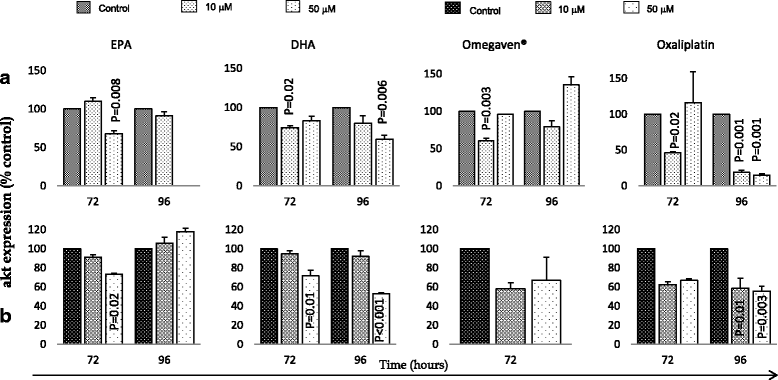Effects of Omegaven®, EPA, DHA and oxaliplatin on oesophageal adenocarcinoma cell lines growth, cytokine and cell signal biomarkers expression
- PMID: 29378575
- PMCID: PMC5789622
- DOI: 10.1186/s12944-018-0664-1
Effects of Omegaven®, EPA, DHA and oxaliplatin on oesophageal adenocarcinoma cell lines growth, cytokine and cell signal biomarkers expression
Abstract
Background: There is limited evidence assessing the effects of omega-3 polyunsaturated fatty acids (PUFAs) on oesophageal adenocarcinoma, both in vitro and in vivo. We evaluated the effects of the omega-3 PUFA and oxaliplatin on OE33 and OE19 cells.
Method: The two oesophageal cells were treated with Omegaven® (fish oil emulsion), EPA, DHA and oxaliplatin and incubated for up to 144 h.
Results: The following inhibitory effects were observed on OE33 cells: EPA reduced cell growth by 39% (p = 0.001), DHA by 59% (p < 0.000) and Oxaliplatin by 77% (p < 0.000). For OE19 cells, the EPA reduced growth by 1% (p = 0.992), DHA by 26% (p = 0.019) and oxaliplatin by 76% (p < 0.000). For both cells, Omegaven® resulted in reduced cell growth at intermediate concentrations (20-40 μM) and increased cell growth at low (10 μM) and high (50 μM) concentrations. DHA, Omegaven® and oxaliplatin were associated with significant downregulation of VEGF and p53 protein, and upregulation of p21 protein. DHA, Omegaven® and Oxaliplatin also led to significant downregulation of the total ERK1/2 and Akt proteins.
Conclusion: DHA, Omegaven® and oxaliplatin were associated with downregulation of p53 and VEGF in both cells. Of the PUFAs studied, DHA alone or in combination (Omegaven®) had greater in vitro anti-cancer effects than EPA alone.
Conflict of interest statement
Ethics approval and consent to participate
Not applicable
Consent for publication
Not applicable
Competing interests
A M Eltweri, A R Dennison and D J Bowrey received departmental grant support from Fresenius Kabi for clinical trial investigating the effects of Omegaven® intravenous supplement in patients with advanced oesophagogastric adenocarcinoma receiving palliative chemotherapy. A R Dennison have received speaking honoraria from Fresenius Kabi. D J Bowrey has received departmental grant support for unrelated work from Nutricia. The other authors have no conflicts to declare.
Publisher’s Note
Springer Nature remains neutral with regard to jurisdictional claims in published maps and institutional affiliations.
Figures





Similar articles
-
The Effect of Supplementary Omegaven® on the Clinical Outcome of Patients With Advanced Esophagogastric Adenocarcinoma Receiving Palliative Epirubicin, Oxaliplatin, and Capecitabine Chemotherapy: A Phase II clinical trial.Anticancer Res. 2019 Feb;39(2):853-861. doi: 10.21873/anticanres.13185. Anticancer Res. 2019. PMID: 30711967 Clinical Trial.
-
Plasma and erythrocyte uptake of omega-3 fatty acids from an intravenous fish oil based lipid emulsion in patients with advanced oesophagogastric cancer.Clin Nutr. 2017 Jun;36(3):768-774. doi: 10.1016/j.clnu.2016.06.001. Epub 2016 Jun 7. Clin Nutr. 2017. PMID: 27342748
-
Treatment of LS174T colorectal cancer stem-like cells with n-3 PUFAs induces growth suppression through inhibition of survivin expression and induction of caspase-3 activation.Cell Oncol (Dordr). 2016 Feb;39(1):69-77. doi: 10.1007/s13402-015-0254-4. Epub 2015 Dec 15. Cell Oncol (Dordr). 2016. PMID: 26671842
-
Potential applications of fish oils rich in omega-3 polyunsaturated fatty acids in the management of gastrointestinal cancer.Clin Nutr. 2017 Feb;36(1):65-78. doi: 10.1016/j.clnu.2016.01.007. Epub 2016 Jan 15. Clin Nutr. 2017. PMID: 26833289 Review.
-
Eicosapentaenoic Acid Versus Docosahexaenoic Acid as Options for Vascular Risk Prevention: A Fish Story.Am J Ther. 2016 May-Jun;23(3):e905-10. doi: 10.1097/MJT.0000000000000165. Am J Ther. 2016. PMID: 25828517 Review.
Cited by
-
100% Fish oil-based lipid emulsion inhibits hepatic stellate cell activation via suppression of the TGF-β1 autocrine signaling.Hum Cell. 2025 Aug 27;38(5):153. doi: 10.1007/s13577-025-01283-y. Hum Cell. 2025. PMID: 40864218
-
EPA and DHA promote cell proliferation and enhance activity of the Akt-TOR-S6K anabolic signaling pathway in primary muscle cells of turbot (Scophthalmus maximus L.).Fish Physiol Biochem. 2024 Aug;50(4):1483-1494. doi: 10.1007/s10695-024-01351-4. Epub 2024 May 30. Fish Physiol Biochem. 2024. PMID: 38814520
-
MYCN and PRC1 cooperatively repress docosahexaenoic acid synthesis in neuroblastoma via ELOVL2.J Exp Clin Cancer Res. 2019 Dec 19;38(1):498. doi: 10.1186/s13046-019-1492-5. J Exp Clin Cancer Res. 2019. PMID: 31856871 Free PMC article.
-
Omega-3 Polyunsaturated Fatty Acids and Their Bioactive Metabolites in Gastrointestinal Malignancies Related to Unresolved Inflammation. A Review.Front Pharmacol. 2019 Aug 2;10:852. doi: 10.3389/fphar.2019.00852. eCollection 2019. Front Pharmacol. 2019. PMID: 31427966 Free PMC article. Review.
-
Association between red blood cell fatty acids composition and risk of esophageal cancer: a hospital-based case-control study.Lipids Health Dis. 2025 Mar 20;24(1):101. doi: 10.1186/s12944-025-02531-8. Lipids Health Dis. 2025. PMID: 40114210 Free PMC article.
References
-
- Eltweri AM, Thomas AL, Metcalfe M, Calder PC, Dennison AR, Bowrey DJ. Potential applications of fish oils rich in omega-3 polyunsaturated fatty acids in the management of gastrointestinal cancer. Clin Nutr. 2016; - PubMed
MeSH terms
Substances
Supplementary concepts
LinkOut - more resources
Full Text Sources
Other Literature Sources
Medical
Research Materials
Miscellaneous

